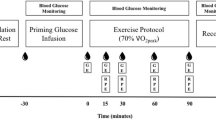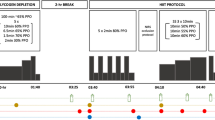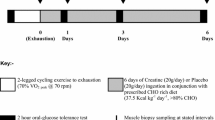Summary
The effect of a pattern of exercise and dietary modifications, which was designed to produce alterations in the muscle glycogen content, on the capacity to perform anaerobic exercise was investigated. Six young male subjects worked to exhaustion on a bicycle ergometer at a supramaximal work load equivalent to 104±5% of \(\dot V\)O2 max after a normal diet, after a carbohydrate (CHO)-free diet following prolonged exhausting exersise, and after a high-CHO diet. This regimen has previously been shown to cause changes in the glycogen content of the working muscle. Mean work time for subjects on the first test was 4.87±1.07 min (mean ± SD). After the low-CHO diet, the time for which work could be maintained was reduced to 3.32±0.93 min, whereas administration of the high-CHO diet resulted in an increase to 6.65±1.39 min. The resting blood lactate concentration was lower than normal following the low-CHO diet and higher than normal following the high-CHO diet. Post exercise blood lactate concentrations reached a peak between 2 and 6 min after exhaustion and again were lower (8.60±1.58 mmol/l) after the low-CHO diet and higher (12.86±1.42 mmol/l) after the high-CHO diet than after performing the same intensity of work to exhaustion on a normal diet (11.66±1.16 mmol/l). The rate of lactate accumulation appeared to be approximately the same during exercise under all three dietary conditions. If this is the case, it suggests that the alterations in endurance capacity do not result from changes in the rate of anaerobic glycolytic energy production, but possibly from a change in the total capacity of the system.
Similar content being viewed by others
References
Ahlborg B, Bergstrom J, Brohult J, Ekelund LG, Hultman E, Maschio G (1967) Human muscle glycogen content and capacity for prolonged exercise after different diets. Forsvarsmedicin 3: 85–89
Asmussen E, Klausen K, Nielson LE, Techow DSA, Tonder PJ (1974) Lactate production and anaerobic work capacity after prolonged exercise in man. Acta Physiol Scand 90: 731–742
Astrand PO, Saltin B (1961) Oxygen uptake during the first minutes of heavy muscular exercise. J Appl Physiol 16: 971–976
Bergstrom J, Hultman E (1966) Muscle glycogen synthesis after exercise. An enhancing factor localised to the muscle cells in man. Nature 210: 309–310
Bergstrom J, Hermansen L, Hultman E, Saltin B (1967) Diet, muscle glycogen and physical performance. Acta Physiol Scand 71: 140–150
Diamant B, Karlsson J, Saltin B (1968) Muscle tissue lactate after maximal exercise in man. Acta Physiol Scand 72: 383–384
Hermansen L, Hultman E, Saltin B (1967) Muscle glycogen during prolonged severe exercise. Acta Physiol Scand 71: 129–139
Hirche H, Wacker U, Langohr HD (1971) Accumulation of lactic acid in skeletal muscle at onset of exercise. In: Gilbert J, Guille GG (eds) Onset of exercise. University of Toulouse, Toulouse, pp 156–165
Hultman E, Bergstrom J (1973) Local energy supplying substrates as limiting factors in different types of leg muscle work in normal man. In: Keul J (ed) Limiting factors of physical performance. Thieme, Stuttgart, pp 113–125
Karlsson J (1971) Lactate and phosphagen concentrations in working muscle of man. Acta Physiol Scand [Suppl 358] 81: 1–72
Karlsson J, Saltin B (1970) Lactate, ATP, and CP in working muscles during exhaustive exercise in man. J Appl Physiol 29: 598–602
Kelman GR, Maughan RJ, Williams C (1975) The effect of dietary modifications on blood lactate during exercise. J Physiol 251: 34P-35P
Klausen K, Piehl K, Saltin B (1975) Muscle glycogen stores and capacity for anaerobic work. In: Howald H, Poortmans J (eds) Metabolic adaptations to prolonged physical exercise. BirkhÄuser, Basel, pp 127–129
McCance RA, Widdowson E (1960) Composition of foods. MRC Special Report Series 297. HMSO, London
Olsen L (1971) An enzymatic fluorimetric micromethod for the determination of acetoacetate, ΒOH-butyrate, pyruvate, and lactate. Clin Chim Acta 33: 293–300
Sahlin K (1978) Intracellular pH and energy metabolism in skeletal muscle of man. Acta Physiol Scand [Suppl 455] 103: 1–56
Saltin B, Hermansen L (1967) Glycogen stores and prolonged severe exercise. In: Blix G (ed) Symposium of Swedish Nutrition Foundation vol 5. Almquist and Wiksell, Uppsala, pp 32–46
Saltin B, Karlsson J (1971) Muscle glycogen utilisation during work of different intensities. Adv Exp Med Biol 11: 289–299
Tesch P (1980) Muscle fatigue in man with special reference to lactate accumulation during short-term intense exercise. Acta Physiol Scand [Suppl 480] 109: 1–40
Thomson JA, Green HJ, Houston ME (1979) Muscle glycogen depletion patterns in fast twitch subgroups of man during submaximal and supramaximal exercise. Pflügers Arch 379: 105–108
Author information
Authors and Affiliations
Rights and permissions
About this article
Cite this article
Maughan, R.J., Poole, D.C. The effects of a glycogen-loading regimen on the capacity to perform anaerobic exercise. Europ. J. Appl. Physiol. 46, 211–219 (1981). https://doi.org/10.1007/BF00423397
Accepted:
Issue Date:
DOI: https://doi.org/10.1007/BF00423397




